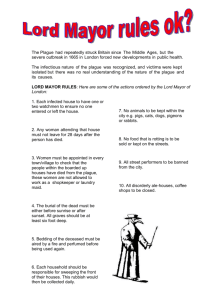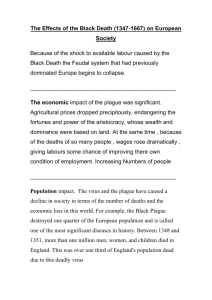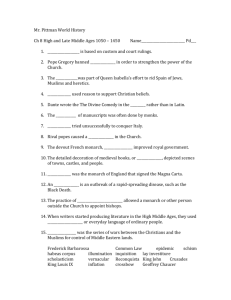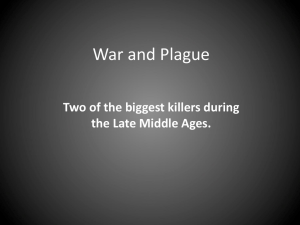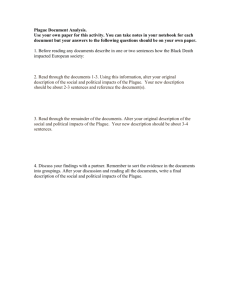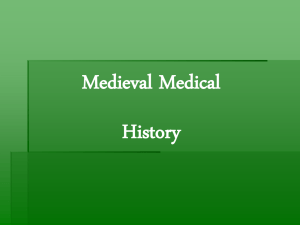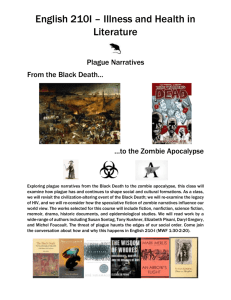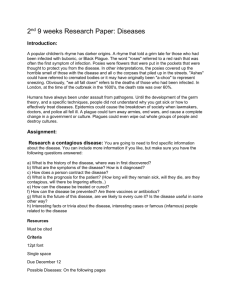The Black Death - Binghamton City Schools
advertisement
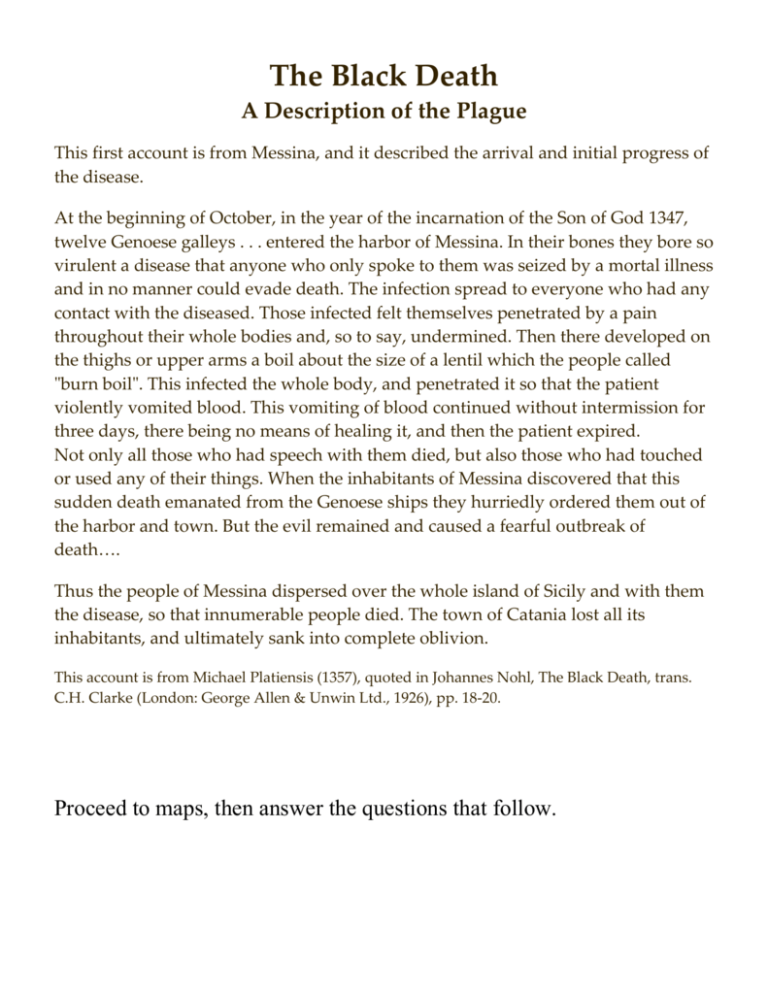
The Black Death A Description of the Plague This first account is from Messina, and it described the arrival and initial progress of the disease. At the beginning of October, in the year of the incarnation of the Son of God 1347, twelve Genoese galleys . . . entered the harbor of Messina. In their bones they bore so virulent a disease that anyone who only spoke to them was seized by a mortal illness and in no manner could evade death. The infection spread to everyone who had any contact with the diseased. Those infected felt themselves penetrated by a pain throughout their whole bodies and, so to say, undermined. Then there developed on the thighs or upper arms a boil about the size of a lentil which the people called "burn boil". This infected the whole body, and penetrated it so that the patient violently vomited blood. This vomiting of blood continued without intermission for three days, there being no means of healing it, and then the patient expired. Not only all those who had speech with them died, but also those who had touched or used any of their things. When the inhabitants of Messina discovered that this sudden death emanated from the Genoese ships they hurriedly ordered them out of the harbor and town. But the evil remained and caused a fearful outbreak of death…. Thus the people of Messina dispersed over the whole island of Sicily and with them the disease, so that innumerable people died. The town of Catania lost all its inhabitants, and ultimately sank into complete oblivion. This account is from Michael Platiensis (1357), quoted in Johannes Nohl, The Black Death, trans. C.H. Clarke (London: George Allen & Unwin Ltd., 1926), pp. 18-20. Proceed to maps, then answer the questions that follow. Spread of the Black Death (1347-1350) Also see the map at the web link below from your textbook (p.400 in text): http://www.classzone.com/cz/books/wh_survey05/secured/resources/applications/ebo ok/index.jsp 1) From where did the merchant ships likely come before stopping at Messina? 2) How did the disease spread to such a large area so rapidly? 3) Why did people fear this illness? The Black Death About the Disease What was this disease? Bubonic plague is the medical term. It is a bacillus, an organism, most usually carried by rodents. Fleas infest the animal (rats, but other rodents as well), and these fleas move freely over to human hosts. The flea then regurgitates the blood from the rat into the human, infecting the human. The rat dies. The human dies. The flea lives a long and happy life. Nature has a morbid sense of humor. Symptoms include high fevers and aching limbs and vomiting of blood. Most characteristic is a swelling of the lymph nodes. These glands can be found in the neck, armpits and groin. The swelling protrudes and is easily visible; its blackish coloring gives the disease its name: the Black Death. The swellings continue to expand until they eventually burst, with death following soon after. The whole process, from first symptoms of fever and aches, to final expiration, lasts only three or four days. The swiftness of the disease, the terrible pain, the grotesque appearance of the victims, all served to make the plague especially terrifying. History of Western Civilization E.L. Skip Knox Boise State University 1) What was the true cause of the spread of the disease? 2) What do you think scared people the most about this illness?? The Black Death Medical Measures When the government acts to prevent or control a calamity, but the calamity persists, people turn to other cures. Many believed that the disease was transmitted upon the air, probably because the smell from the dead and dying was so awful. So, the living turned to scents to ward off the deadly vapors. People burned all manner of incense: juniper, laurel, pine, beech, lemon leaves, rosemary, camphor, sulpher and others Handkerchiefs were dipped in aromatic oils, to cover the face when going out. The cure of sound was another remedy. Towns rang church bells to drive the plague away, for the ringing of town bells was done in crises of all kinds. Other towns fired cannons, which were new and which made comfortingly loud din. And there was no end of talismans, charms and spells that could be purchased from the local wise woman or apothecary. People were desperate for a cure and would try anything, no matter how outlandish or strange. History of Western Civilization E.L. Skip Knox Boise State University 1) How did people believe the plague spread? 2) Why would these remedies have no chance at stopping this disease? 3) Why did people do these things? The Plague Doctor Medieval and later-era plague suit, re-creation. Outfits of this type, worn by medieval physicians and made of cloth or leather, were uniquely associated with the plague in Europe. In addition to serving as a probable physical barrier to the plague pathogen, the suits had symbolic significance. The ability of birds to travel between earth and sky may have represented mediation between the earth and heaven. The costume's bird-like beak contained spices and vinegar-soaked cloth to mask the stench of death and decay and make the physicians' work less unbearable. Given what you have learned about the disease, do you think that the doctor’s outfit would have protected him from contracting the plague? Explain why or why not. The Black Death Learned Opinion The cause of the disease was a matter of concern to many. Popular opinion did view the plague as a scourge from God, for the times were indeed out of joint. This was mere vulgar opinion, however, and the learned knew better than to believe it. But what, then, was the source of the plague? The pope sent to Paris to obtain the opinions of the medical faculty there in 1348. They studied the problem for a time and returned a report. The good professors opined that the disaster was caused by a particularly unfortunate conjunction of Saturn, Jupiter and Mars in the sign of Aquarius that had occurred in 1345. This conjunction cause hot, moist conditions, which cause the earth to exhale poisonous vapors. The report went on to recommend steps to keep safe from the disease. This, in part, was their prescription: No poultry should be eaten, no waterfowl, no pig, no old beef, altogether no fat meat. . . . It is injurious to sleep during the daytime. . . . Fish should not be eaten, too much exercise may be injurious . . . and nothing should be cooked in rainwater. Olive oil with food is deadly. . . . Bathing is dangerous. . . . In time, other writings appeared from the pens of educated men on the best ways to avoid the plague. From Italy came this advice: In the first instance, no man should think of death. . . . Nothing should distress him, but all his thoughts should be directed to pleasing, agreeable and delicious things. . . . Beautiful landscapes, fine gardens should be visited, particularly when aromatic plants are flowering. . . . Listening to beautiful, melodious songs is wholesome. . . . The contemplating of gold and silver and other precious stones is comforting to the heart. History of Western Civilization E.L. Skip Knox Boise State University 1) What did popular opinion suggest was the cause of the plague? 2) What did the Pope's committee conclude about how the plague started? 3) Do their recommendations to avoid the plague fit with the suspected cause? What does this tell you about European medical knowledge at the time? The Black Death The Economy The economy was probably hit the hardest of all the aspects of Europe. The biggest problem was that valuable artisan skills disappeared when large numbers of the working class died. Therefore, those who had skills became even more valuable than the rich people. The society structure began to change giving formally poor laborers more say. The peasants and artisans demanded higher wages. Serfs seeking liberation from tilling their lord's land were told by decree and statue to return to their master's duties. The poor people saw so much death they wanted to enjoy life. Serfs began to leave their land and not engage in the planting of crops. Unattended crops and stray animals died of starvation because of the lack of care. Several domesticated animals began to roam the forest. Farming communities became rare. The lack of sufficient law enforcement personnel promoted lawlessness. People called "Bechini" pillaged homes, murdering and raping people. They dressed in red robes with red masks and only their eyes showed. The horror of the Black Death had taken on a new victim, the economy. 1) How did the plague affect the economy in terms of agriculture? 2) How did the plague affect the feudal structure? 3) From a social perspective, what was happening all over Europe? The Black Death Effects on the Church One of the groups that suffered the most was the Christian church. It lost prestige, spiritual authority, and leadership over the people. How? The church promised cures, treatment, and an explanation for the plague. They said it was God's will, but the reason for this awful punishment was unknown. People wanted answers, but the priests and bishops didn't have any. The clergy abandoned their Christian duties and fled. People prayed to God and begged for forgiveness. After the plague, ended angry and frustrated villagers started to revolt against the church. The survivors were also enraged at doctors, who didn't cure patients, but said they could. 1) Why did the Church’s reputation suffer after of the plague? 2) What happened to the Church when the epidemic had passed? The Black Death Cultural Effects As the chroniclers said, the plague touched everyone, rich and poor alike. The noted Florentine historian, Villani, wrote this: "And many lands and cities were made desolate. And the plague lasted until __________" Villani left a blank at the end of the sentence, planning to fill in a date after the plague had abated. He never did. Villani died in 1348 from the plague. The whole community of scholars suffered as universities and schools, usually located in regions hardest hit, were closed or even abandoned. Sixteen of the forty professors at Cambridge died. Likewise in the institutions of the Church. The priests died and no one could hear confession. Bishops died, and so did their successors and even their successors. The loss of life in such great numbers and to so gruesome a disease, brought despair everywhere. Why would God do this? and why could not His servants in the Church avert or mitigate His wrath? "During this great epidemic of death [in Tuscany] more than eighty died of every hundred, and the air was so infested that death overtook men everywhere, wherever they might flee. And when they saw everybody dying they no longer heeded death and believed that the end of the world was at hand." The tone in this exerpt finds echoes throughout Europe. There were those indeed who believed this calamity marked the end of the world. Even after the crisis had passed, and the world remained, there were those who wondered why God should have so scourged the world. History of Western Civilization E.L. Skip Knox Boise State University 1) Accoring to this excerpt, what was the cause of the plague? 2) What institutions suffered from the massive deaths? The Dance Macabre Pictured are a nobleman, a Knight and a noble child 1) What do the Skeletons represent? 2) What does this picture suggest about social position and the nature of the plague? Spread of the Black Death (1347-1350) Quiz 1. How did the plague spread so rapidly across Europe? a) fleas on rats b) It was hereditary c) Unsanitary foods from the East d) Asian computer virus 2. What was the social impact of the plague on Europe? a) All of Europe banded together to fight the plague b) Brother turned against brother c) Society was knit closer together in the end d) Families moved closer to each other 3. What was the impact of the plague on the Church? a) The Church grew in power b) Many people abandoned hope in the church c) The priests were good examples to their flocks d) The church invested millions in disease research 4. How did the plague impact Europe's economy? a) Europe stayed prosperous through continued trade with the East b) Agriculture boomed since crops were in high demand c) The economy became stagnant and dropped d) Medical insurance companies went bankrupt
